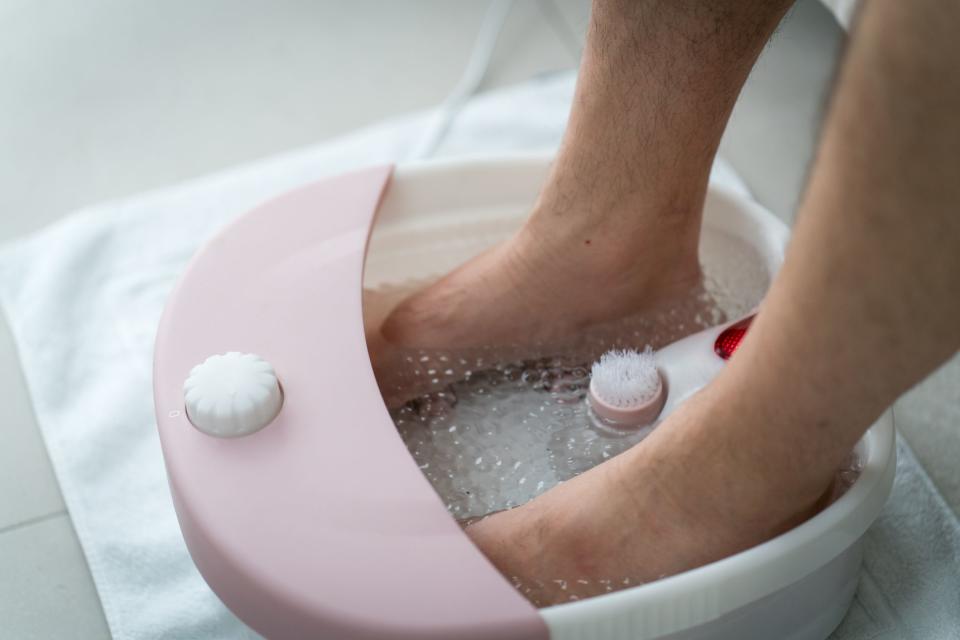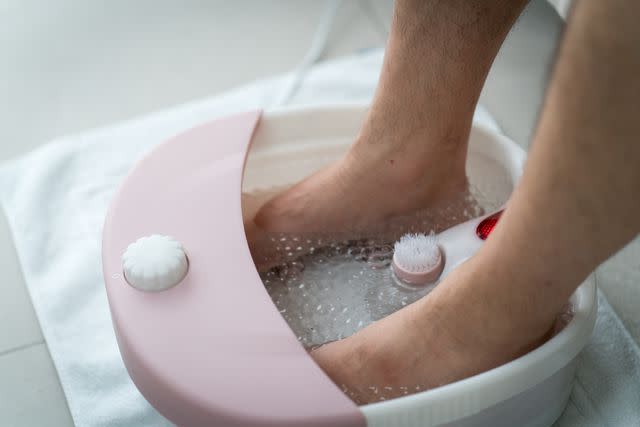Are There Benefits to a Listerine Foot Soak?
A Home Remedy For Athlete’s Foot, Cracked Heels, and Callouses

Jasmin Merdan
Medically reviewed by Danielle McNeil, D.P.M
A Listerine foot soak is, as the name suggests, an at-home treatment that involves soaking your feet in a bath of Listerine mouthwash and water. Proponents of this therapy say that it may help treat athlete's foot (a fungal foot infection), soothe dry, cracked, and scaly feet, and even treat diabetic foot pain.
Ingredients in Listerine contain antibacterial, antioxidant, and antifungal properties. However, there are no official studies to back any claims about the benefits of a Listerine foot soak.
That said, this remedy is inexpensive, easy to make, and safe for most people, if you want to give it a try.
This article explores the possible benefits of a Listerine foot soak, gives recipe options, and explains when it should be avoided.

Jasmin Merdan / Getty Images
Listerine Foot Soak Benefits
There is no research regarding Listerine foot soaks specifically. But research does confirm that essential oils found in Listerine have beneficial antimicrobial and antifungal properties that may help kill fungi and bacteria and soothe skin.
Beneficial properties may include:
Antiseptic: Thymol, the main active compound in thyme has antibacterial, antifungal, anti-parasitic, and antioxidant qualities.
Anti-itch: Thymol also has anti-inflammatory properties that may also soothe skin irritation and redness. Menthol, an oil from the menthol plant, has anti-itch, and pain-relieving qualities.
Cooling: Menthol has a cooling effect that makes it a common ingredient in icy-hot patches and other similar products.
Anti-inflammatory: Eucalyptol, the main active compound in eucalyptus, has anti-inflammatory and antioxidant qualities and can help speed up recovery time. Research shows that eucalyptol has tremendous potential for treating diabetes-related pain and infectious diseases.
Improved absorption: Methyl salicylate, a compound derived from wintergreen or sweet birch bark, is a common ingredient in topicals used to treat musculoskeletal aches and pains. Methyl salicylate also helps the skin absorb other herbal ingredients better.
Simply soaking your feet in warm water has benefits in and of itself: As anyone who has ever gotten a pedicure knows, enjoying a warm footbath can be relaxing and soothing to the skin.
The practice also has study-proven benefits: Several studies have found that soaking feet and lower legs in warm water for 20 to 60 minutes before bed significantly improves sleep quality. Other studies suggest a footbath can help improve circulation to the lower extremities.
There is little evidence that vinegar will cure a toenail fungus, but it may help. Research shows that vinegar slows the growth of some funguses including Candida, the fungus responsible for athlete's foot.
Listerine Foot Soak Recipes
For a basic Listerine foot wash, you will need three things:
Listerine mouthwash
Warm water
A large bucket or tub that is large enough to fit both of your feet
To do a Listerine foot soak:
Prepare your Listerine foot soak at the sink.
Add one part warm water and one part Listerine mouthwash until there's enough to submerge your feet.
Grab your bucket and find someplace comfortable to sit.
Soak your feet for 45 to 60 minutes.
Wash your feet with cool water and dry them thoroughly.
Repeat daily or as often as possible until the fungus clears up.
Don't have enough time to soak for 45 minutes to an hour? You'll still get some benefits from a shorter 20- to 30-minute soak.
Before trying any DIY treatment on the skin, especially if you have a skin condition or open wounds, contact your healthcare provider to make sure the ingredients are safe for you to use.
Recipe Variations
For when you want to give your feet an even more thorough soak or do some exfoliating, consider adding additional ingredients to your mixture such as:
Epsom salt
Lemon juice
White or apple cider vinegar
To modify your Listerine foot soak recipe, options include:
Mix equal parts warm water and Listerine to cover your feet; stir in 1 cup of Epsom salt.
Mix 1 cup of Listerine and a few drops of lemon juice into 1 gallon of warm water.
Mix 1 gallon of warm water, ½ cup of Listerine, and ½ cup of white or apple cider vinegar.
For an extra relaxing scent, you can also add a few drops of lavender oil or other fragrant essential oils.
You can also use a cotton ball to apply Listerine directly to a fungus-infected toenail to help treat the infection.
Who Shouldn't Use a Listerine Foot Soak
A Listerine foot soak should be avoided if you have the following conditions:
Blisters on the feet
Open sores, cuts, or cracked skin on the feet
Allergies to menthol, thymol, methyl salicylate, or eucalyptus. (Always do a patch test before trying Listerine on the skin.)
Contact dermatitis, psoriasis, or other inflammatory skin conditions
Signs of infection, such as changes in skin color or odor
Bleeding from the feet
Diabetes (as Listerine can be irritating to the skin)
If you notice anything unusual on your feet or have a foot fungus that has gone untreated for a long time, make an appointment with your healthcare provider. They can give you a diagnosis and advise you on the proper treatment.
More severe fungal or bacterial infections need to be seen by a healthcare provider.
Summary
Listerine foot soaks have become popular as a possible treatment for athlete's foot and other fungal infections of the feet. While there is no research to verify the benefits of this practice, Listerine does contain four antimicrobial essential oils that may be effective at killing fungi.
A Word From Verywell
Soaking your feet in Listerine may sound a little funky. But if this practice intrigues you, there's no real harm in trying it, as long as you don't have any other skin conditions. A Listerine foot soak may even have some benefits, like cooling you off, easing aches and pains, or helping you sleep.
That said, using an over-the-counter antifungal cream or other medical treatment is still the fastest, more effective way to clear up athlete's foot and toenail fungus.
Frequently Asked Questions
What ingredients get rid of dead foot skin?
You can make a DIY exfoliating foot scrub by mixing 1 cup of sugar or salt with a few tablespoons of coconut oil or mixing baking soda with water to form a paste. Use it to scrub away any dead skin from your feet.
How long should you soak in a Listerine foot bath?
The general recommendation is to soak your feet for 45 to 60 minutes. This allows plenty of time for the essential oils in the mixture to soak into skin and toenails and kill the fungus. A shorter soak of 20 to 30 minutes will still have benefits.

